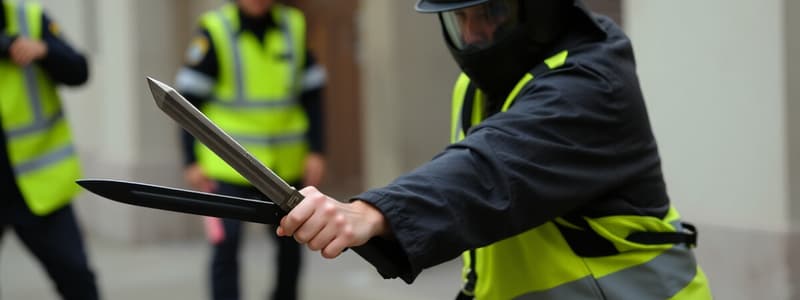Podcast
Questions and Answers
What should be your first response when faced with an edged-weapon attack up close?
What should be your first response when faced with an edged-weapon attack up close?
- Immediately call for backup.
- Attempt to disengage and plan a counterattack.
- Try to negotiate with the attacker.
- Use empty-hand techniques only as a last resort. (correct)
What is the minimum safe distance to react to an edged-weapon attack without injury?
What is the minimum safe distance to react to an edged-weapon attack without injury?
- 30 feet
- 15 feet
- 25 feet (correct)
- 10 feet
Which of the following can be used to create a barrier between you and an attacker?
Which of the following can be used to create a barrier between you and an attacker?
- A mobile phone
- Nearby animals
- Unauthorized persons
- Obstacles like furniture or vehicles (correct)
How can awareness impact your ability to defend against an edged-weapon attack?
How can awareness impact your ability to defend against an edged-weapon attack?
What mindset should you develop in preparation for a potential edged-weapon encounter?
What mindset should you develop in preparation for a potential edged-weapon encounter?
Which of the following is a common attack pattern for a knife-wielding subject?
Which of the following is a common attack pattern for a knife-wielding subject?
What is the purpose of redirecting techniques during an edged-weapon attack?
What is the purpose of redirecting techniques during an edged-weapon attack?
What is one reason you might have limited options in responding to an attack?
What is one reason you might have limited options in responding to an attack?
What is the primary goal of using redirection and evasion techniques against an edged weapon attack?
What is the primary goal of using redirection and evasion techniques against an edged weapon attack?
Which technique involves sidestepping or shifting to avoid an edged weapon attack?
Which technique involves sidestepping or shifting to avoid an edged weapon attack?
Which of the following is NOT part of the first redirection technique?
Which of the following is NOT part of the first redirection technique?
What should be done throughout the application of redirection techniques?
What should be done throughout the application of redirection techniques?
What action is taken to create distance from the weapon during the first redirection technique?
What action is taken to create distance from the weapon during the first redirection technique?
In the second redirection technique, what is done to control the subject’s arm?
In the second redirection technique, what is done to control the subject’s arm?
What is a necessary follow-up action after applying redirection techniques?
What is a necessary follow-up action after applying redirection techniques?
What is the reason for moving at an angle or circling away from an attacker?
What is the reason for moving at an angle or circling away from an attacker?
Flashcards
Edged Weapon Defense
Edged Weapon Defense
Techniques used to defend against an attacker wielding a knife, or other edged weapon.
Knife Attack Patterns
Knife Attack Patterns
Common ways knife-wielding attackers strike (straight thrust, overhead attack, forehand slash).
Safe Distance (Edged Weapon)
Safe Distance (Edged Weapon)
The minimum distance necessary for a safe reaction to an edged weapon attack.
Defensive Movements (Close Quarters)
Defensive Movements (Close Quarters)
Signup and view all the flashcards
Straight Thrust
Straight Thrust
Signup and view all the flashcards
Overhead Attack (Knife)
Overhead Attack (Knife)
Signup and view all the flashcards
Forehand Slash (with a knife)
Forehand Slash (with a knife)
Signup and view all the flashcards
Survival Mindset
Survival Mindset
Signup and view all the flashcards
Redirection Technique
Redirection Technique
Signup and view all the flashcards
Evasion Technique
Evasion Technique
Signup and view all the flashcards
Redirection Technique (1)
Redirection Technique (1)
Signup and view all the flashcards
Redirection Technique (2)
Redirection Technique (2)
Signup and view all the flashcards
Verbal Commands
Verbal Commands
Signup and view all the flashcards
Edged Weapon Defense
Edged Weapon Defense
Signup and view all the flashcards
Angle/Circle Movement
Angle/Circle Movement
Signup and view all the flashcards
Weapon Arm Control
Weapon Arm Control
Signup and view all the flashcards
Study Notes
Defensive Tactics Against Edged Weapons
- Lesson Goal: Demonstrate defense against an attacker using an edged weapon.
- Knife Fighting: A sophisticated technique, this lesson provides basic knowledge.
- Deadly Force Response: Defense against edged weapons, bottles, clubs, or blunt instruments may require a deadly force response. Use empty-hand techniques only when no other options exist.
- Distance and Time: An attack involving distance or imminent threat gives time to plan, respond, and possibly disengage. A sudden, close-range attack limits options, and empty-hand techniques may be the best defense.
- Early Identification: Identifying a threat early improves the defensive response. Less time to react reduces options. Awareness helps recognize cues and warning signs.
- Redirection Techniques: Use redirecting tactics to avoid or redirect an attack to create time for disengagement or escape.
- Safe Distance: The minimum safe distance for officers to react to an edged-weapon attack without injury is about 25 feet.
Knife Attack Patterns
- Straight Thrust: Attack using a forward motion.
- Overhead Attack: Attack from above, using one or two hands.
- Forehand Slash: Attack with the blade moving forward and downward.
Defensive Movements
- Evasion: Moving away from the attacker to avoid the attack.
- Secure Weapon Arm: Controlling or capturing the attacker's weapon arm.
- Redirect Weapon Arm: Changing the direction of the attacker's weapon using techniques.
Redirection Techniques (1)
- Verbal Commands: Loud and clear verbal commands throughout the technique.
- Pivot Backward: Pivoting backward to evade the attacker's initial movement.
- Protect Vital Areas: Protecting face and vital areas with hands.
- Create Distance: Pushing, slapping, or striking attacker's arm to create distance from the weapon.
- Move Away: Moving away from the attacker in an angled or circular motion.
- Follow Up: Following up with appropriate actions.
Redirection Technique (2)
- Blocking Techniques: Blocking the attacker's lower right arm with your left arm.
- Grasping Weapon Arm: Grasping the attacker's right arm just above the elbow.
- Pulling Action: Slightly pulling the attacker off-balance, straightening the attacker's arm, and pulling their right wrist downwards to the right hip.
- Downward Pressure: Applying downward pressure to the attacker's elbow while maintaining control of the wrist.
- Strikes/Diversions: Using strikes or diversions as necessary.
- Rotating Hips: Rotating hips clockwise by moving the right leg backward.
- Prone Position: Dropping to the left knee and placing the attacker in a prone position.
- Follow Up: Following up with appropriate actions.
Defense Against Overhead Stab/Forehand Slash
- Palm Strike: Using both hands to palm-strike the attacker's upper right arm near the shoulder to stop weapon movement.
- Capture and Secure: Capturing and securing the attacker's right arm by circling with your left arm.
- Deliver Strikes: Delivering multiple disabling strikes simultaneously.
- Follow Up: Following up with appropriate/additional actions.
Studying That Suits You
Use AI to generate personalized quizzes and flashcards to suit your learning preferences.




